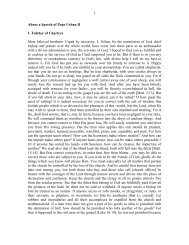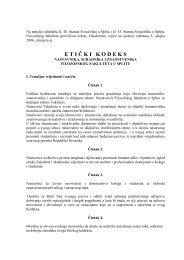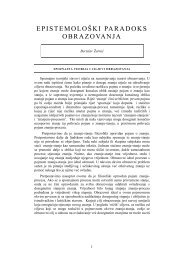Understanding Human Communication
Understanding Human Communication
Understanding Human Communication
Create successful ePaper yourself
Turn your PDF publications into a flip-book with our unique Google optimized e-Paper software.
318 PART THREE COMMUNICATION IN GROUPS<br />
CULTURAL IDIOM<br />
off the wall: unconventional,<br />
ridiculous<br />
go along with the crowd: agree<br />
with the majority<br />
rock the boat: disturb a stable<br />
condition<br />
Conformity and Nonconformity:<br />
Long and Short Views<br />
When we look a little closer, we see<br />
an inconsistency in the way our<br />
society seems to feel about<br />
conformity (team playing) and<br />
nonconformity (deviance). For<br />
example, one of the great best-sellers<br />
of the 1950s was a book by John F.<br />
Kennedy called Profiles in Courage,<br />
wherein the author praised several<br />
politicians for their courage in<br />
resisting great pressure and refusing<br />
to conform. To put it another way,<br />
Kennedy was praising people who<br />
refused to be good team players,<br />
people who refused to vote or act as<br />
their parties or constituents expected<br />
them to. Although their actions earned<br />
Kennedy’s praise long after the deeds<br />
were done, the immediate reactions<br />
of their colleagues were generally far<br />
from positive. The nonconformist may<br />
be praised by historians or idolized in<br />
films or literature long after the fact of<br />
his nonconformity, but he’s usually not<br />
held in high esteem, at the time, by<br />
those people to whose demands he<br />
refuses to conform.<br />
Elliot Aronson<br />
The Social Animal<br />
Pressure to Conform<br />
There’s a strong tendency for group members to go along with the crowd,<br />
which often results in bad decisions. A classic study by Solomon Asch illustrated<br />
this point.College students were shown three lines of different lengths and asked<br />
to identify which of them matched with a fourth line. Although the correct answer<br />
was obvious, the experiment was a setup: Asch had instructed all but one<br />
member of the experimental groups to vote for the wrong line. As a result, fully<br />
one-third of the uninformed subjects ignored their own good judgment and voted<br />
with the majority. If simple tasks like this one generate such conformity, it is<br />
easy to see that following the (sometimes mistaken) crowd is even more likely<br />
in the much more complex and ambiguous tasks that most groups face.<br />
Even when there’s no overt pressure to follow the majority, more subtle influences<br />
motivate members—especially in highly cohesive groups—to keep quiet<br />
rather than voice any thoughts that deviate from what appears to be the consensus.“Why<br />
rock the boat if I’m the only dissenter?”members think.“And if everybody<br />
else feels the same way, they’re probably right.”<br />
With no dissent, the group begins to take on a feeling of invulnerability: an<br />
unquestioning belief that its ideas are correct and even morally right. As its position<br />
solidifies, outsiders who disagree can be viewed as the enemy, disloyal to<br />
what is obviously the only legitimate viewpoint. Social scientists use the term<br />
groupthink to describe a group’s collective striving for unanimity that discourages<br />
realistic appraisals of alternatives to its chosen decision. 43 Several group practices<br />
can discourage this troublesome force. 44 A first step is to recognize the prob-<br />
Source: THEFARSIDE © 1984 FARWORKS, INC. Used by permission. All Rights Reserved.

















